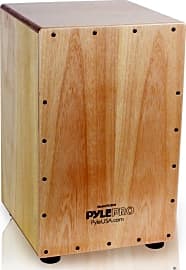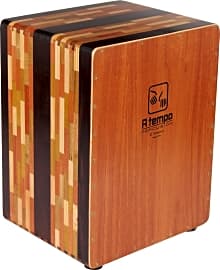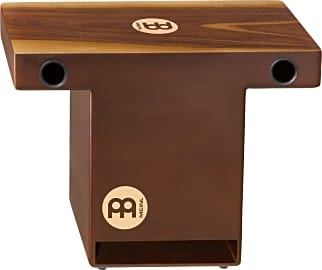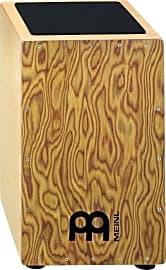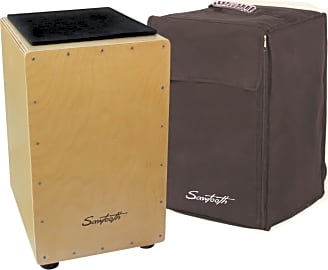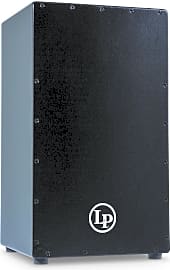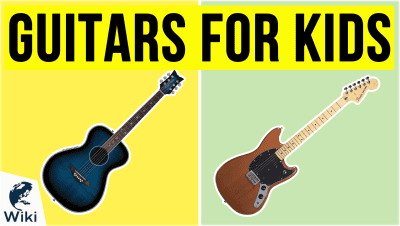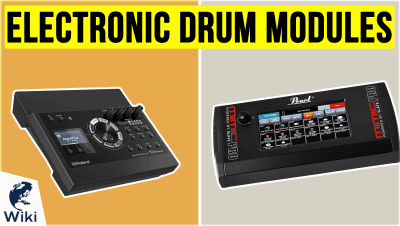The 10 Best Cajons

This wiki has been updated 34 times since it was first published in October of 2016. The cajon is a box-shaped percussion instrument with Peruvian origins that is played by slapping the front or rear surfaces with the palms and fingers, and, sometimes, brushes, mallets, and sticks. Though it is traditionally used in flamenco, conga, and Afro-Peruvian music, it is capable of producing a variety of rich sounds that complement a wide array of other genres. When users buy our independently chosen editorial recommendations, we may earn commissions to help fund the Wiki.
Editor's Notes
May 31, 2019:
This update sees the A Tempo Percussion Dos Voces jump from its previous spot at #6 all the way to #1. Initially designed in Peru, handcrafted by Peruvians, and marketed, in part, for Peruvian musicians, it's certainly best-suited for traditional genres, but because of its dual-surfaced design, you can achieve totally different timbres (as well as volume levels) depending on which side you're using.
While Meinl's popular models still hold spots in our ranking at #8 and #7, we bumped the Makah Burl down a bit from its previous standing after recognizing the superior qualities of the LP American Groove, which we've bumped to #6.
We kept the Pyle PCJD18 at #2 for its cost-value. We believe it makes a great option for bands touring with an acoustic set, as it is lightweight and constructed well enough to get banged around a bit en route from one gig to the next.
Though they've each taken a bump down one position on our ranking, we still stand by our #3, #4, and #5 picks, made by Sol Percussion, Schlagwerk, and Gon Bops, respectively, as they continue to stand the test of time.
Special Honors
Levia Omeya Bass Studio Made from 100% Russian birch from an FSC-accredited factory, this costly beauty comes alive in the high end; however, its vibrant treble tones take the back seat to what is a useful technical innovation, which is the Bass-Studio System. The system offers two features: 1) a somewhat standard removable sound port for better projection/micing capabilities; and 2) an adjustable bottom vent that that extends directly to the floor, allowing for tonal variations that few other models are capable of. Thanks to this, the bass-end's depth is something to behold. Overall, it offers undeniable professional-level quality that is equally viable for live performance or studio settings. leivapercussion.com
A Brief History Of Cajons
In the mid to late 19th century, musicians started experimenting with different cajon designs.
The Cajon appears to be a descendant of a variety of boxlike musical instruments that were found in West and Central regions of Africa. Historically, the cajon has been most widely used in Afro-Peruvian music, though it has made its way into a variety of modern music genres and can currently be found in musical performances throughout the Americas, Spain, and the Philippines.
The rise in popularity of the cajon most likely came about sometime in the 18th century as a result of African slavery in Peru. Two complementing theories can explain why they become such a cultural symbol at the time. The African slaves working in port cities had a large number of Spanish shipping crates at their disposal, which they could easily adapt into a box drum somewhat reminiscent of those found in their homeland. This was also a time when the Spanish colonies were placing bans on slave music. The slave masters worried that allowing slaves to listen to the songs of their homeland could fuel emotions towards a common cause or even result in open rebellion. The box-like nature of the cajon meant that it could be quickly and easily disguised as a stool when needed. The combination of Spanish suppression of slave music and African origins seem to have created the perfect atmosphere for the development of the cajon.
The cajon was also widely used in Cuba in the 1960s. Just a few years after Castro turned Cuba into a communist country in 1959, disenchanted and marginalized masses started to hold anti-communist rallies in the streets, complete with chanting, singing, and rhythmic drumming. Fearing the sound of beating drums would draw more people to the protests, and thereby more people to the cause potentially leading to open rebellion, Castro outlawed playing music in the street. To get around this, Cubans started to make drums out of fruit boxes and other crude materials that could be easily disguised as everyday items. When the police arrived to break up a rally, they would find well-behaved citizens sitting atop their boxes, looking for work or socializing.
Over time, the cajon has become a true musical instrument in its own right. In the mid to late 19th century, musicians started experimenting with different cajon designs. They bent the planks to alter the tone, added internal wires to give it a snare sound, and some have even incorporated tiny tambourine cymbals, adding new dimensions to the types of sounds cajons can produce.
How To Choose The Right Cajon
Choosing the right cajon is as personal as choosing a favorite pair of jeans; no two people will want the exact same thing. Here are a few things to keep in mind as you evaluate different cajons to see if they fit your needs. Always remember that price doesn't necessarily directly correlate with quality. This doesn't mean that you should go out and buy the cheapest model available, but realize that big name branding often adds to the price tag, without necessarily adding to the quality. Take a look at the materials used to construct the cajon. Models made from high density hardwoods will offer a better frequency range, being able to produce high-cracking notes, deep resonating bass, and punchier bass tones, as well.
The bigger the cajon, the deeper the bass it can produce and the louder it can get.
Consider the type of music you plan on playing the most. Each type of cajon is best suited to certain tones, hence certain genres of music. If you play rock music the majority of the time, a cajon that features a snare system is a good choice. A snare system helps a cajon produce more rattle and buzz in the high notes. The downside to this is that it makes them sound a little less articulate when played fast. Flamenco and Latin cajons often have a guitar strings or wires running along the backside of the tapa. This helps them produce tighter and crisper sounds that are perfect for higher bongo- or conga-like tones. If you really want the traditional Afro-Peruvian sound, choose a model without wires, strings, or a snare system. These will be better at creating rich, resonating bass tones.
You should also look at the design of a cajon. The port placement will affect the volume and tone. Cajons with a port in the center will have the most volume, but the least tones. As the port moves closer to the bottom, the volume decreases but the tones increase. Size is another factor that affects tone and volume. The bigger the cajon, the deeper the bass it can produce and the louder it can get. Small cajons are less expensive, but are quieter and can't reach very deep bass notes.
Cajon Playing Tips For Beginners
Posture is extremely important when playing a cajon. Because of the way cajons are designed to be played while sitting on top of them, many people naturally want to hunch over them. Playing this way can quickly lead to back pain after practice sessions, resulting in a person deciding that a cajon is not the instrument for them. In actuality though, a cajon should be played with your back mostly straight, in a relaxed, but not hunched position. All of a cajon's tones can be achieved in the top eight inches of the tapa and sides, so there really is no reason to bend over far and try and hit lower areas. Not only will using the correct posture reduce the possibility of soreness or back pain, it will also improve your technique, agility, and speed.
Your first few practice sessions should be spent finding all of the tones of your cajon. Experiment by hitting the instrument in different spots and paying attention to the tone each area creates. You may be surprised to learn that a cajon is capable of considerably more tones than most people expect. Having knowledge of all the different tones that your instrument can produce gives you the ability to create a more varied sound to your music, thereby adding more complexity to your rhythms.
Using a metronome can greatly help to improve you timing, speed, and beat-keeping accuracy. It may seem mind-numbing at first, but having good timing and beat-keeping accuracy is vital to becoming a high-level percussionist.


